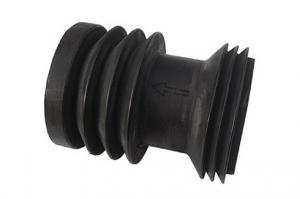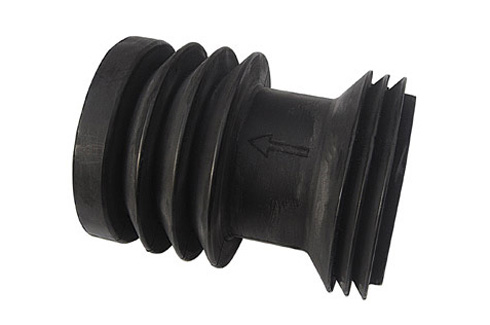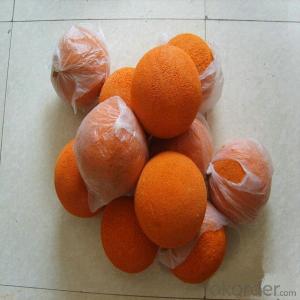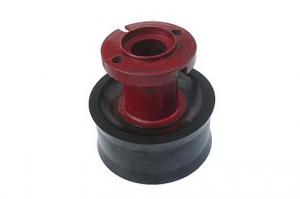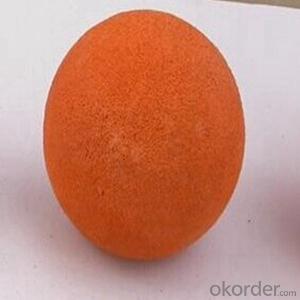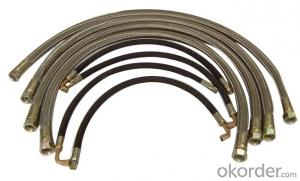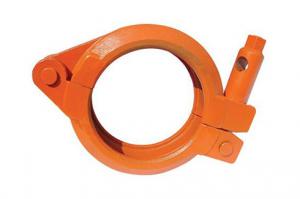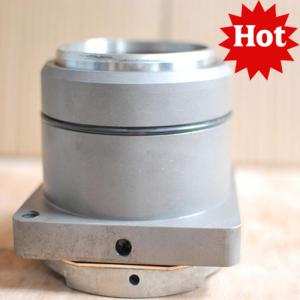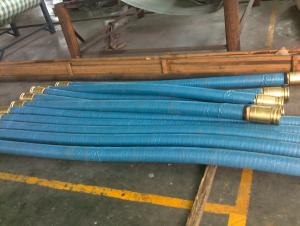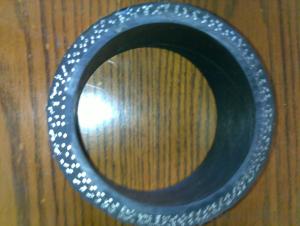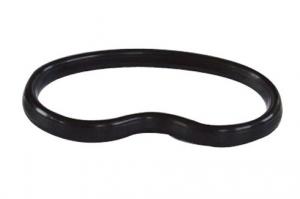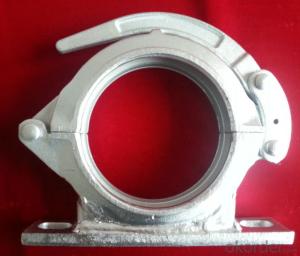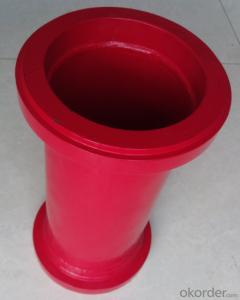Concrete Pump Parts Cleaning Rubber Piston
- Loading Port:
- China Main Port
- Payment Terms:
- TT OR LC
- Min Order Qty:
- -
- Supply Capability:
- -
OKorder Service Pledge
OKorder Financial Service
You Might Also Like
Including: 1) Wear-resisting Board andCutting ink for Schwing, Putzmeister, Sany, Zoomlion, Kyokuto
2) Seal Ring/ Gasket for Schwing, Putzmeister, Sany
3) Schwing Kidney 10029138
4) Pipe Clean-out Accessories: Sponge ball, Sponge Column, Cleaningpiston
5) Conveying Cylinder for Schwing, Putzmeister
Products:
1) Rubber hose
2) Putzmeister/ Schwing/ Zoomlion/ SermacRam Pistons
3) Putzmeister/ IHI/ Kyokuto/ Zoomlion/Sany Seperated Piston
4) Wear-resisting board and Cuts ink
5) Coupling and seal ring for Putzmeister,Schwing, Sany
6) ST52 steel pipe, elbow, reducer
7) Cleaning seriesand others- Q: How often should concrete pump hydraulic filters be inspected and replaced?
- Concrete pump hydraulic filters should be inspected and replaced on a regular basis, ideally every 500 hours of operation or according to the manufacturer's recommendations. Regular inspection and replacement of hydraulic filters help ensure the proper functioning and longevity of the concrete pump.
- Q: What are the consequences of using substandard concrete pump spare parts?
- Using substandard concrete pump spare parts can have several consequences. Firstly, these parts may not fit properly or have the same level of durability as genuine parts, leading to frequent breakdowns and disruptions in construction projects. This can result in delays and increased costs for repairs or replacements. Secondly, substandard parts may compromise the overall performance and efficiency of the concrete pump. This can lead to decreased productivity, lower quality concrete output, and potential safety hazards for workers. Moreover, using low-quality spare parts can void warranties and insurance coverage, leaving the project owner or contractor liable for any damages or accidents that may occur. Lastly, relying on substandard parts can negatively impact the reputation and credibility of the construction company. Clients may lose trust in their ability to deliver high-quality work, leading to a loss of business opportunities in the future. In conclusion, the consequences of using substandard concrete pump spare parts include increased costs, project delays, compromised performance, safety risks, legal liabilities, and damage to a company's reputation. Therefore, it is crucial to invest in genuine and high-quality spare parts to ensure smooth and efficient construction operations.
- Q: How often should concrete pump hydraulic oil coolers be inspected and maintained?
- Concrete pump hydraulic oil coolers should be inspected and maintained regularly, ideally on a monthly basis or as recommended by the manufacturer. Regular inspections and maintenance ensure optimal performance and help identify any potential issues or damage that may affect the efficiency and lifespan of the equipment.
- Q: How to diagnose the blockage in the inlet of concrete pump?
- The feed port is blocked and the pump operation and hydraulic system are normal, with no abnormal sound and vibration. The hopper has larger aggregate or agglomerates and is stuck or arched at the feed port
- Q: What are the indications of a faulty concrete pump seal?
- Some indications of a faulty concrete pump seal may include leakage of hydraulic fluid, excessive noise or vibration during operation, reduced pumping efficiency, and potential damage to other components of the pump.
- Q: How can the concrete pump be installed and used?
- When cleaning the pipe, the operator shall leave the pipe outlet and the elbow joint. If the pipe is cleaned with compressed air, there shall be no personnel and equipment at the outlet of the pipe at 10m
- Q: How can one determine the correct size and dimensions of concrete pump spare parts?
- To determine the correct size and dimensions of concrete pump spare parts, there are several important steps to follow: 1. Identify the specific make and model of your concrete pump: Each concrete pump has its own unique specifications and requirements for spare parts. Therefore, it is crucial to know the make and model of your pump before ordering any spare parts. 2. Consult the manufacturer's documentation: Manufacturers often provide detailed documentation that includes information on the required size and dimensions of spare parts. This documentation may include technical drawings, diagrams, and part numbers that can help you find the correct size. 3. Measure the existing spare part: If you already have a spare part that needs replacement, you can measure its size and dimensions using precision tools like calipers or a measuring tape. Take accurate measurements of key dimensions such as length, width, height, and any other relevant specifications. 4. Seek professional assistance: If you are unsure about the correct size and dimensions, it is advisable to consult with a professional or an authorized dealer. They have expertise in concrete pumps and can guide you in selecting the right spare parts based on your pump's specifications. 5. Consider compatibility and quality: When purchasing spare parts, ensure they are compatible with your concrete pump's make and model. Additionally, prioritize quality to ensure longevity and optimal performance. Buying from reputable suppliers or directly from the manufacturer can help ensure the spare parts meet the necessary size, dimensions, and quality standards. By following these steps, you can accurately determine the correct size and dimensions of concrete pump spare parts, ensuring smooth operation and minimizing downtime.
- Q: How can I determine if the concrete pump cylinder needs replacement?
- In order to determine whether the concrete pump cylinder needs replacement, several inspections and tests can be conducted. 1. Perform a visual inspection and look for any visible signs of wear and tear on the cylinder, such as cracks, dents, or corrosion. Additionally, check for leaks or excessive hydraulic fluid around the cylinder. 2. Evaluate the pump's performance during operation. Pay attention to any decrease in pumping efficiency, irregular flow, or decreased pressure, as these could indicate a problem with the cylinder. 3. Conduct a pressure test to assess the cylinder's ability to handle the required pressure. This can be done by isolating the cylinder and pressurizing it to a level higher than its typical operating pressure. If the cylinder fails to maintain pressure or shows signs of leakage, replacement may be necessary. 4. Measure the stroke length of the cylinder during operation. Uneven stroke lengths may indicate internal damage and could require replacement. 5. If you are uncertain about the cylinder's condition, seek consultation with professionals or experts in the field. They can provide a more accurate assessment and recommend the appropriate course of action, which may include cylinder replacement. Remember that regular maintenance and inspections are essential for the concrete pump's longevity and efficient operation. Addressing potential issues early on can help prevent further damage or accidents.
- Q: What are the signs of a damaged or malfunctioning electric motor?
- A damaged or malfunctioning electric motor can be identified by several signs. Firstly, unusual noises like grinding, squealing, or banging sounds are typically indicative of a problem. Such sounds may suggest that the motor's bearings are worn out or that there is an issue with its internal components. Secondly, excessive heat is another sign of a damaged electric motor. If the motor feels hotter than usual to the touch, it could indicate that the motor is working harder than it should or that there is an issue with its cooling system. Thirdly, a motor that frequently trips the circuit breaker or blows fuses clearly indicates a malfunction. This could be caused by an electrical fault within the motor or an overload due to a faulty component. Furthermore, a damaged electric motor may exhibit reduced performance or a noticeable decrease in power output. This can be observed as a decrease in speed or torque produced by the motor, or even a complete inability to start or function properly. Lastly, excessive vibration or shaking of the motor may indicate misalignment or a problem with its mounting. If not addressed promptly, this can lead to further damage. If any of these signs are noticed, it is recommended to immediately cease using the motor and seek the assistance of a qualified technician or electrician to diagnose and repair the issue. Ignoring or continuing to use a damaged motor can result in further damage and potentially dangerous situations.
- Q: What are the indications of a clogged or damaged concrete pump filter?
- Some indications of a clogged or damaged concrete pump filter include decreased pumping pressure, reduced flow rate, increased fuel consumption, and irregular or inconsistent concrete output. Additionally, if the concrete pump filter is severely clogged or damaged, it may cause the pump to overheat or shut down completely. It is important to regularly inspect and clean or replace the filter to ensure optimal performance and prevent any potential damage to the pump.
Send your message to us
Concrete Pump Parts Cleaning Rubber Piston
- Loading Port:
- China Main Port
- Payment Terms:
- TT OR LC
- Min Order Qty:
- -
- Supply Capability:
- -
OKorder Service Pledge
OKorder Financial Service
Similar products
Hot products
Hot Searches
Related keywords
